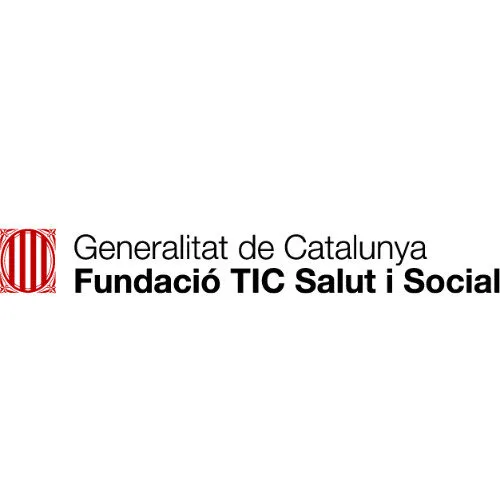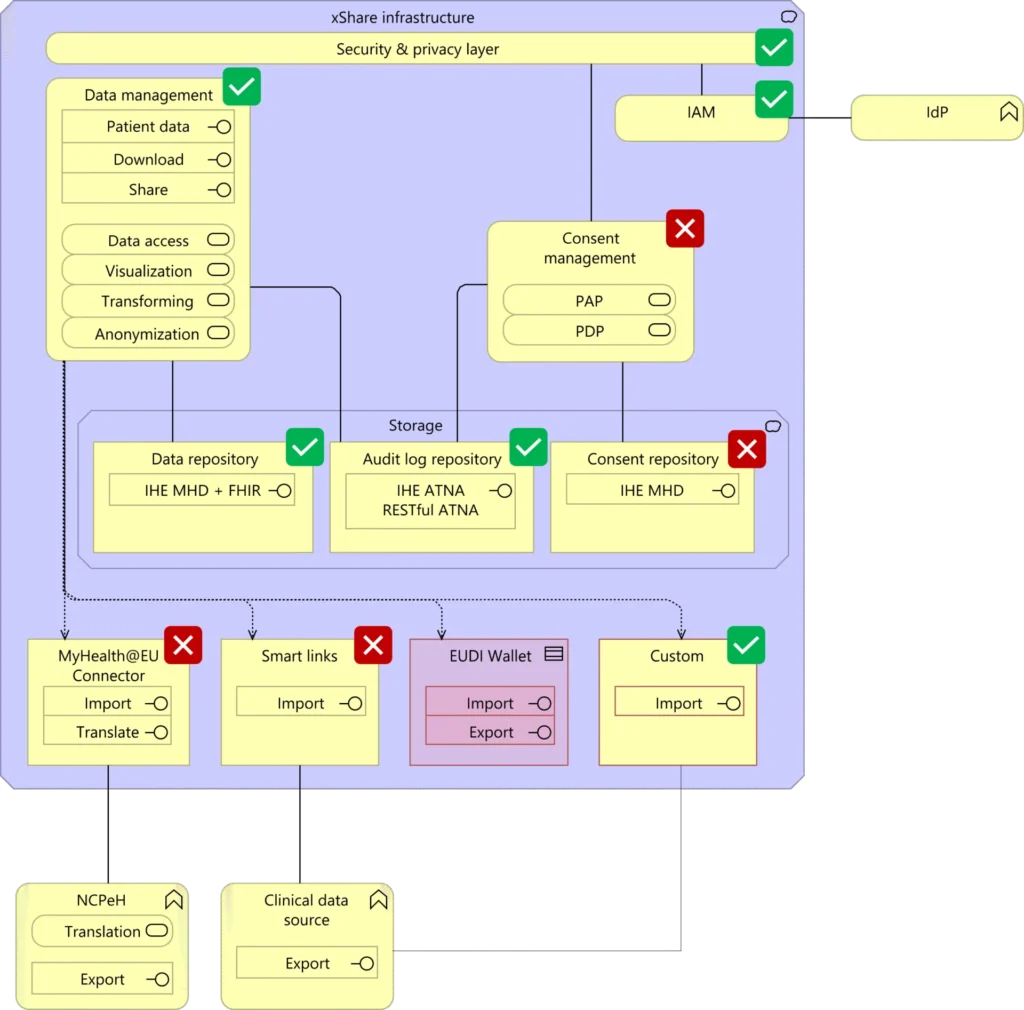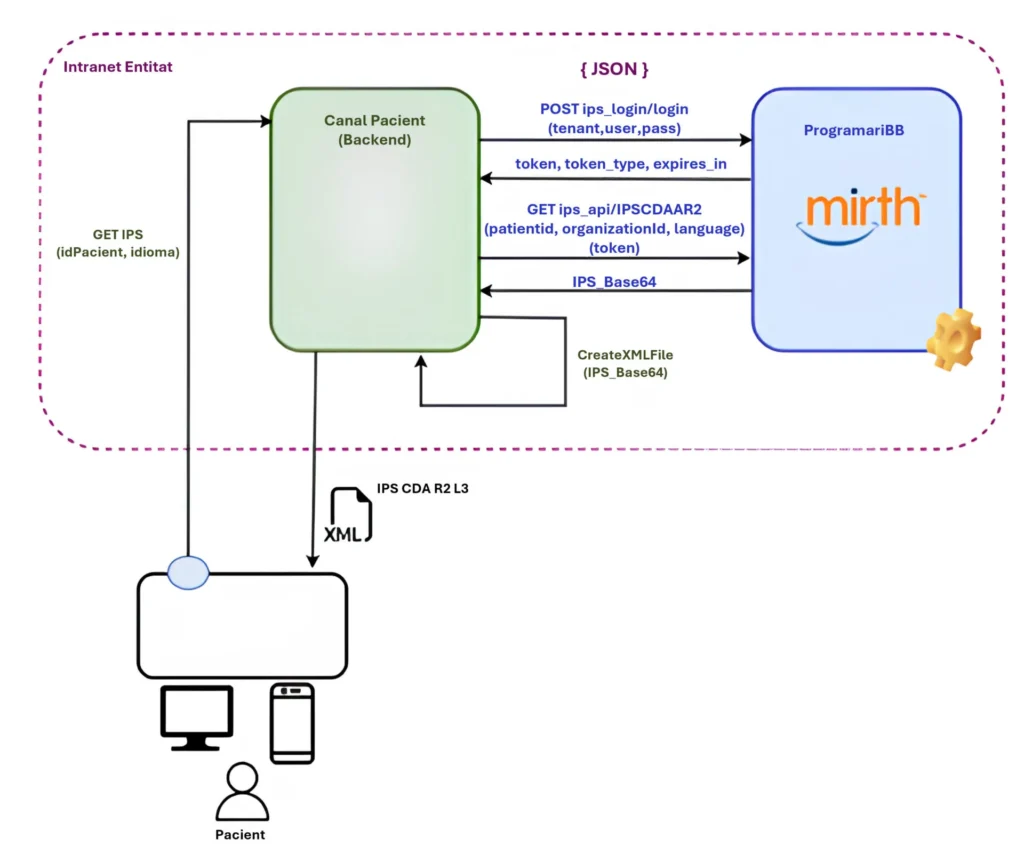
The TIC Salut Social Foundation (FTSS) is a public agency under the Catalan Ministry of Health and the Ministry of Social Rights and Inclusion. It fosters innovation in health and social care through the strategic use of ICT. FTSS supports the integration of digital solutions across the Catalan Health and Social Care System (SISCAT), which encompasses more than 2,600 healthcare and social care resources. These include around 68 hospitals, 434 primary care centres, 40 mental health institutions, and 102 residential and long-term care facilities. In this context, resources refer not only to entire centres but also to specific units or services within them, such as community mental health teams, day hospitals or local consulting rooms. Together, these resources ensure universal public access to care for Catalonia’s eight million inhabitants.
The Catalan Public Healthcare System offers the secure Yellow Button tool within the La Meva Salut (LMS) platform, allowing citizens to download their clinical data—including the International Patient Summary (IPS) in XML format—for cross-border healthcare use. The IPS contains key health information like diagnoses, medications, and immunizations.
During the project, FTSS aims to enhance the tool’s reliability in the IPS content and implement the solution in the private sector to enable seamless data exchange between public and private providers. Additional developments include a mobile application IPS viewer for citizens that can visualize one single IPS or more than one in a combined view (it is in a testing stage).
Considering the reference architecture, in the case of this adoption site, the following blocks are considered:

| Public | Private | |
| Security, Privacy & Authentication | Access via La Meva Salut (LMS) using ID (ID-Cat Mobil) and two-factor-authentication (2FA). Registration requires in-person verification. | Access with application user/password + token. Only works inside the organization’s intranet. No patient data is stored. |
| Data Management by Custom Connectors | Data from EHR, transformed into CDA/FHIR using IHE guides. | Data from organization DB is transformed into FHIR resources using Mith Connect integrations engine. Using this resources, the CDA R2 L3 or FHIR Bundle formats can be generated. |
| Consent Management | Not included. Patient handles all actions. | Not included. IPS is downloaded by the patient. |
| MyHealth@EU Connector | Not included, under consideration. | Not included, evaluating its usefulness. |
| Smart Links | Not included, under consideration. | Not included, evaluating its usefulness. |
| Data repository | MHD profile being implemented to receive patient CDA. | No patient data is stored. Internal DB holds mappings, controlled vocabularies, audit log, etc. |
| Audit repository | Sends ATNA data export message to an IHE certified Audit Record Repository. Implementation and certification of IHE ATNA profile ARR and SA actors at Trieste 2024. | Includes FHIR-based auditlog management. |
| Consent repository | Not included. Patient handles all actions. | Not included. IPS is downloaded by the patient. |
As an implementation scenario, the next figure shows how the different blocks are implemented and interconnected in the specific case of private sector in this adoption site.

| Month Range | Public Sector | Private Sector |
| M0–M3 | Kick-off: "Botó Blau" launched in "La Meva Salut" for CDA IPS download by the citizen | Kick-off: Needs assessment and situational analysis in private centers |
| M4–M6 | BUC definition - Confirm format and compliance of IPS download in CDA (diagnoses, medication, allergies, etc.) and eP/eD (visible by citizen in PDF) | BUC definition - Develop "BB software" for CDA R2 L3 + implementation guide |
| M7–M9 | BUC definition - Continue IPS format validation and compliance | BUC definition - Begin development of IPS Viewer App (CDA format); prep PoC sites |
| M10–M12 | Personas/User stories/Requirements definition - Finalize IPS quality enhancements | Personas definition - Run PoCs in 2 centers + finalize Viewer App (CDA R2 L3) |
| M13–M15 | Personas/User stories/Requirements definition - Prep for FHIR generation; technical groundwork | Personas/User stories/Requirements definition - Add FHIR generation capabilities ( as additional web service) |
| M16–M18 | Personas/User stories/Requirements definition - Implement FHIR output (CDA to FHIR mapping) | Personas/User stories/Requirements definition - Include FHIR web service for IPS generation and Adapt Viewer App to read FHIR-formatted IPS and multiple FHIR documents merging |
| M19–M21 | Prep LMS for upload interface (via eConsulta or secure channel, non-integrated) | Validation of Viewer and prepare piloting session and inclusion of more centers |
| M22–M24 | Enable IPS upload in LMS (manual via eConsulta or other secure channel) | Situational analysis in new centers |
| M25–M27 | Launch access to IPS Viewer App directly from LMS | Start piloting with real patients/centers |
| M28–M30 | Viewer refinement and SmartLink/QR code for one-time sharing | Include real centers, test and improve Viewer App for HCPs use |
Public Sector: The next phase will focus on improving the FHIR-based output of the IPS and enhancing key components such as the IPS structure itself: Export capabilities will be expanded, enabling IPS generation in both CDA and FHIR formats to meet the most up-to-date requirements. A future step will be the work on including the upload of clinical documents in CDA format from patients. In addition, the team will assess the feasibility of integrating the MyHealth@EU Connector, the team is also analyzing the theoretical framework for secondary use of data.
Private Sector: The private sector will continue to scale up the initiative by involving more healthcare centres in the testing, with constant monitoring of progress throughout the project period. On the other hand we will start piloting in the centers where the PoC has been implemented. This expansion will help validate the solution in different settings. Testings will be performed to validate the FHIR format.
The IPS Viewer will also be refined to better align with clinical needs and improve usability in real-world scenarios.
calvarez@ticsalutsocial.cat